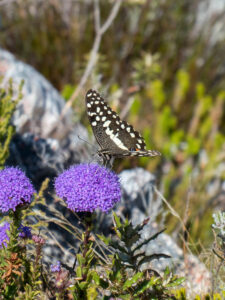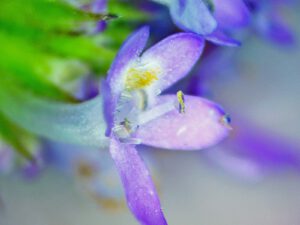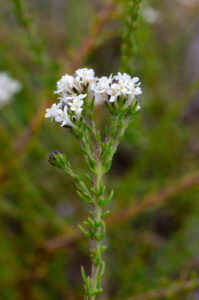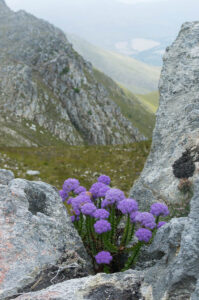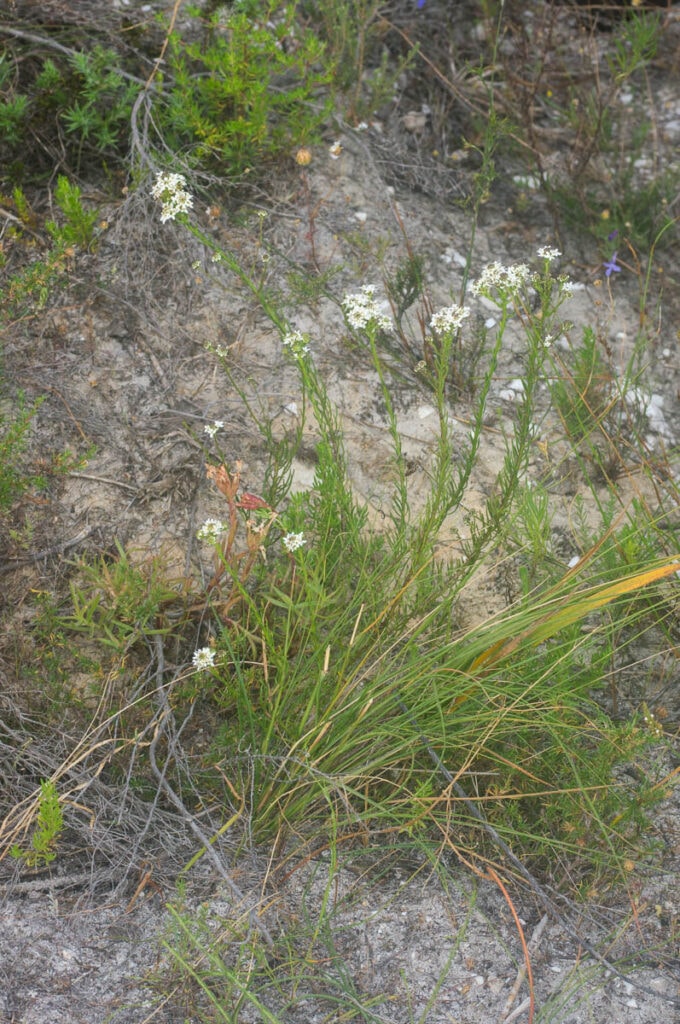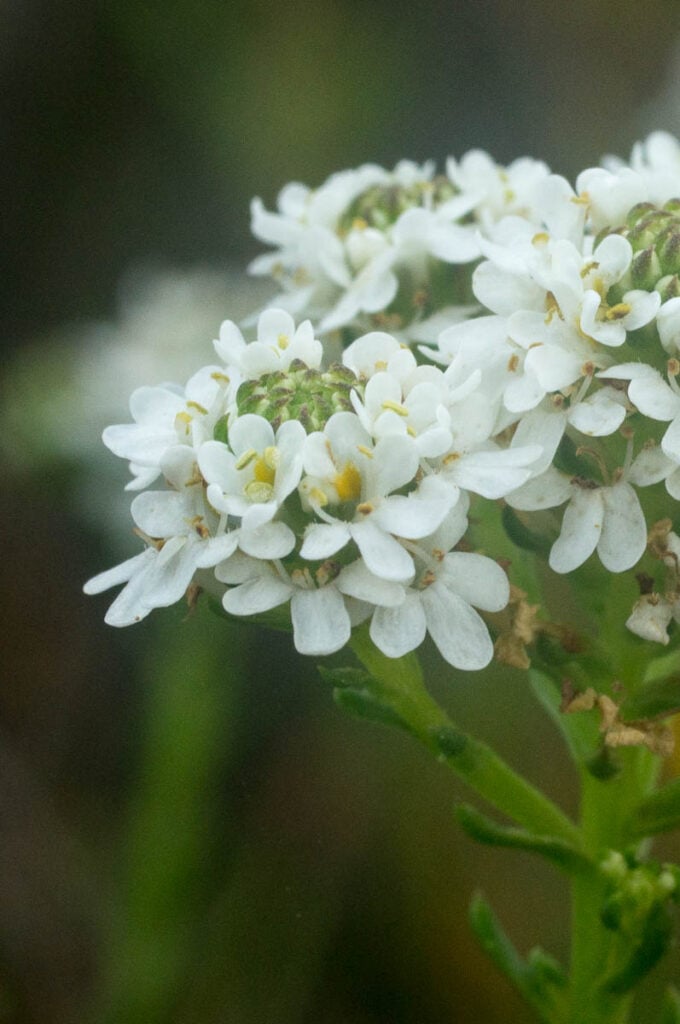Midsummer on the Klein River Mountains sees the arrival of purple clumps of Pseudoselago pulchra. This species must count as one of the most beautiful of the fynbos members of the family Scrophulariaceae and its name reflects that (“pulchra” is the Latin for beautiful). It produces dense domed heads of small deep violet-purple flowers on top of green leafy stems. The flowers have a short tube with five flared petals at the end. Protruding from the centre of the flowers come four short stamens that give the flowerhead a pincushion effect. The whole head provides the perfect landing platform for butterflies, especially those that are particularly attracted to purple coloured flowers, such as the Citrus Swallowtail (Papilio demodocus – see experiment here based on very closely related Papilio demoleus: https://link.springer.com/article/10.1007/BF03050215).
Pseudoselago versus Selago
The genus Pseudoselago is confined to the south-western Cape. The odd name comes from the fact that it was once included in the more widespread genus Selago, but 28 species were split off as they were considered to be “falsely” (“Pseudo”) included in that genus. The two genera differ on a number of small characters, the most significant are the presence of hairs around the mouth of the flowers in Pseudoselago but hairs are absent in Selago. Other easier details to spot, but less consistent, include the way the leaves cluster at the nodes in Selago but rarely do in Pseudoselago and the presence of a different coloured spot near the mouth of the flower in Pseudoselago but absent in Selago. There are also differences in the seeds and fruiting inflorescence as outlined in the table at the bottom.
Pseudoselago pulchra and Pseudoselago serrata
Pseudoselago pulchra is the most eye-catching of the species in the Klein River Mountains. It is very similar and often confused with Pseudoselago serrata from the Kogelberg and Cape Peninsula, but that species has not been recorded eastwards of Bot River. Pseudoselago pulchra differs from Pseudoselago serrata by having the leaves more upright and with the margins with smaller teeth but in a greater number, the inflorescence branches and bracts are glabrous without the short glands of Pseudoselago serrata, and the stamens are longer so that the anthers more visibly protrude above the flowers. The best way of distinguishing them though is on distribution as their ranges do not overlap.
Pseudoselago verbenacea
Within the Klein River Mountains, Pseudoselago pulchra is most likely to be confused with Pseudoselago verbenacea. That species also produces heads of purple flowers but the clusters are not so dense (or so “beautiful”, though nevertheless attractive). The key difference though is in the leaves, which in Pseudoselago verbenacea are opposite all the way up the stem and with clear internodes between them, whereas in Pseudoselago pulchra the leaves in the upper half are alternately distributed around the stem and overlap each other.
Pseudoselago gracilis and Pseudoselago spuria
Two other species have been recorded from this area: Pseudoselago gracilis and Pseudoselago spuria. These are both smaller species, with narrow leaves. The two species are rather similar to one another and possibly hybridise so that distinguishing them is difficult. Typical Pseudoselago spuria occurs from the Cape Peninsula to Sir Lowry’s Pass, while typical Pseudoselago gracilis is found from Ceres northwards. Hilliard, who first described the genus Pseudoselago, was particularly troubled by the plants along the southern Cape coast from Betty’s Bay to Potberg, which fitted neither Pseudoselago spuria nor Pseudoselago gracilis well. It was only “with reluctance that [she] broadened [her] circumscription of P. gracilis to include plants” from the Overberg. In general Pseudoselago gracilis has white flowers, with the leaves only shortening slightly up the stem, while Pseudoselago spuria has purple flowers, with the upper leaves markedly shorter than the lower ones. But the distinction is unclear in the Overberg and the presence of hybrids probably blurs it further.
All the species make attractive garden plants, easily grown in a sunny spot in the garden. Pseudoselago verbenacea in its natural habitat grows where there is a bit more moisture in the soil than the other species. All the species can be short-lived, especially Pseudoselago verbenacea, which can behave as an annual. It is therefore important to continue to propagate them regularly either by seed, or cuttings with the more perennial species.
Key differences between Pseudoselago and Selago
| Pseudoselago | Selago |
| Leaves opposite, often alternate upwards, leaf clusters absent (though developing branches may be present) | Leaves alternate, nearly always with axillary leaf clusters |
| Hairs on stems and leaves thin-walled | Hairs on stems and leaves sculptured |
| Narrow club-shaped hairs always present at least at base of upper lip | Corolla limb without hairs around the mouth |
| Yellow/orange (sometimes whitish?) patch always present at base of upper petals | Corolla limb without a yellow/orange patch at base of upper petals |
| Bract and calyx persisting on axis of inflorescence, basal part of bract then inflated in many species | Bract and calyx eventually falling from axis of inflorescence, base of bract never inflated on the back |
| Seed-bearing cases soft-walled | Seed-bearing cases hard-walled |
| Seeds compressed on one face, convex on the other | Seeds tapered on both sides |
Key to Pseudoselago in Klein River Mountains
| 1. | Stem leaves broad, elliptic to obovate, more than 5mm wide | 2 |
| Stem leaves narrow, linear, less than 2mm wide | 4 | |
| 2. | Leaves opposite all up the stem to beneath the inflorescence. Stem visible between leaf pairs | P. verbenacea |
| Leaves becoming alternate towards the inflorescence, closely overlapping with stem not visible between | 3 | |
| 3. | Leaf only slightly recurving, margins with 7-14 teeth on each side, inflorescence axis and floral bracts glabrous, corolla tube 8-10mm long, fliaments of longer stamens >3mm long | P. pulchra |
| Leaf often strongly recurved, margins with 5-9 teeth on each side, inflorescence axis and floral bracts minutely glandular, corolla tube 5-8mm long, fliaments of longer stamens <3mm long | P. serrata (not present in Klein River Mtns but included here for reference) | |
| 4. | Stems usually branching, leaves spreading to ascending, only gradually smaller upwards, spikes either solitary or up to 5 in a loose corymb, lowermost flowers in a spike often distant, flowers normally white, rarely mauve | P. gracilis |
| Stems usually simple, leaves crowded on lower half and there more or less spreading, on upper half rather abruptly smaller, distant, sharply ascending, spikes arranged in a congested corymb, flowers crowded even at base of spike, flowers shades of mauve or blue | P. spuria (true P. spuria possibly not present and all plants should be included in P. gracilis at present) |






